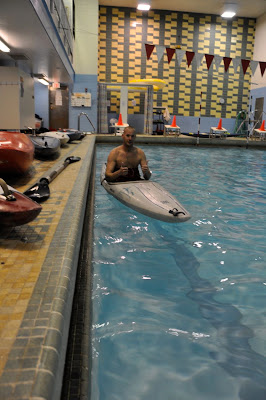 Justine Curgenven. (Photo courtesy of Justine Curgenven.)
Justine Curgenven. (Photo courtesy of Justine Curgenven.)
Over the course of two evenings, we watched
This is the Sea 4. This is a generous package: one disk of shorter profiles of remarkable paddlers and locales; one disk with two longer expeditions.
Disk one follows Justine's now-familiar approach of documenting outstanding kayakers who collectively define the sport. But whereas This is the Sea 1, 2 and 3 were like a kayaking Who's Who and Where's Where , This is the Sea 4 widens the lens to explore the variation and diversity of what can be done with sea kayaks themselves. We meet kayak fishermen off the California coast, whitewater paddlers tackling the Ottawa River in sea kayaks, and a Norwegian father-and-son team who hop around on the tops of their boats in the fjords. We also meet a woman who nurses injured wombats back to health, and see
Hadas Feldman on her home turf. The message of disk one is something like, "All over the world, people are pushing the bounds of what they and their boats can do. Don't be narrow-minded about what sea kayaking is about."
Disk two contains two expedition narratives that, like her earlier ones, show why sea kayak trips are so enticing but don't disguise how hard they can be. The
Haida Gwaii (Queen Charlotte Islands) circumnavigation with Shawna Franklin and Leon Somme manages to be a loving portrait of a remarkable place, a profile of the whimsical and knowledgeable owners of
Body Boat Blade, and a story all in one. (Those of us who met Shawna and Leon at the
West Michigan Coastal Kayakers Association symposium last year got a preview of this trip.)
 Shawna Franklin and Leon Somme. (Photo by Justine Curgenven.)
Shawna Franklin and Leon Somme. (Photo by Justine Curgenven.)
The circumnavigation of the south island of New Zealand with Barry Shaw is considerably more challenging. The two paddled 2,400 kilometers, many of them into stiff headwinds, with limited landing options that were further complicated by punishing surf. At one point, Justine develops an infection and has to be airlifted to a hospital. They often look exhausted and sometimes almost defeated, and share all of that in the footage. At some points, Justine is even too tired to laugh. It's really a brutally honest documentary; she shares the tough decisions, the discouragement and the fear as well as the elation and excitement. That's something we've always appreciated about Justine's work, and it's very much in evidence here.
 Barry Shaw landing through surf. (Photo by Justine Curgenven.)
Barry Shaw landing through surf. (Photo by Justine Curgenven.)We've found, over the years, that we return to each of the This is the Sea DVDs to review segments we love. The same will be true with this one.
Justine and Barry will be showing a one-hour condensed version of This is the Sea 4 and talking about their circumnavigation on Friday, November 14 in St. Charles, IL. Admission is $10, half of which goes to support
Chicago Adventure Therapy. There will be an after-party nearby. For tickets or more information, visit
Geneva Kayak Center or call 630.232.0320.
 There's nothing like getting together with a group of talented coaches and working on skills none of you yet possesses. Last Friday, Scott Fairty took Paul Redzimski, Wendy Madgwick, Bonnie Perry, Lyn Stone, John Martin and the two of us out on the water for a Canoe Two Star assessment and an update of our old BCU Canoe Safety to the new Foundations of Safety and Rescue. That sounds heady and intimidating, and it might have been if not for Scott's laid-back style and the enthusiasm of the group.
There's nothing like getting together with a group of talented coaches and working on skills none of you yet possesses. Last Friday, Scott Fairty took Paul Redzimski, Wendy Madgwick, Bonnie Perry, Lyn Stone, John Martin and the two of us out on the water for a Canoe Two Star assessment and an update of our old BCU Canoe Safety to the new Foundations of Safety and Rescue. That sounds heady and intimidating, and it might have been if not for Scott's laid-back style and the enthusiasm of the group. Emptying out a canoe.
Emptying out a canoe.














































